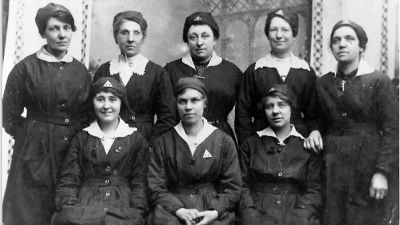New project sheds light on the WW1 women who kept Portsmouth's dockyard running

Frances Johnson grew up with just a few family memories about her Great Aunt Lorna Howes.
Lorna, she was told, had been a worker at Portsmouth Dockyard more than a hundred years ago.
"I knew that she worked in ammunition," she said. "But not to the extent that we found out. We have four granddaughters and I'd like to pass on that legacy to them and let them know about the history of a strong woman."
It turned out that Lorna had been part of an extraordinary and long forgotten band of women - the Triangle Girls.
Named after the brass badges they wore on their overalls, these were women who took over jobs from male workers called up to fight in the First World War. It was vital the building and repair of warships continued.
By October 1918 there were about 2,000 of them at the dockyard, many called up to carry out skilled work in heavy industry. They had to train on the job in fields such as welding, electronics and engineering.
Dennis Miles from the Portsmouth Royal Dockyard Historical Trust said: "They were filling in the gaps for semi-skilled workers. Working on lathes, drills, cleaning out boilers. They earned a reputation for doing very skilled work."
This special group had faded into memory but a new project by the Trust and the University of Portsmouth - funded by National Lottery money - is reviving the memory. It tells the women's stories and education packs are to be handed out to local schools to teach and inspire future generations.
The research has brought to light incredible photos of the labourers at work, complete with the badges which explain how they got their nicknames. They were inscribed with the words 'On War Service'.
Like Lorna Howes, who is pictured in one of the photos, many of the women had family who worked at the docks.
Some already held other jobs there but this was the first time women had been called on to do jobs in heavy industry - something that was controversial at a time when women did not even have the vote.
The government was quick to point out that everything took place in workshops and 'in no way are dockyard women employed in outdoor work'.
They also stressed that they were 'making electrical fittings and operating light machinery'.
In fact this was difficult work in a harsh environment and although the Triangle Girls undertook roles comparable to their male colleagues they were not paid as much.
Nor did they get a warm welcome from those male workers who remained. There were reports of women being jostled and subjected to abusive language.
Beatrice Hobby, a worker interviewed in the 1980s said: "Oh yes, we had an awful time with them in there. They didn't like it because women were in there."
Cheryl Jewitt is a volunteer with the Trust and her grandmother Clara Jones was one of these workers.
“I often wonder how she must have felt walking into the dockyard knowing as I do now, through my volunteering role, what would have confronted her'', she said.
"As well as being an enormous, noisy, dirty and dangerous place many of the men resented their presence and made it known. A dead rat on a woman’s workplace wasn’t unusual."
"At the time the dockyard was a vastly different place from today’s visitor attraction, it must have been terrifying for my grandmother and the other women workers, many of whom would by now be widowed, just to walk through those intimidating dockyard gates.”
Trust CEO Hannah Prowse said: ''The project is to look at the lives of these women and their experiences coming to work in an incredibly male-dominated environment and to understand how many women were here and what they did.
"There were 1,786 of them working in the dockyard at the end of the war. They represented seven point eight per cent of the workforce here.
"Just to put that in context nowadays there are only five per cent of women working in the dockyard on ships. So we have actually gone backwards in terms of females working in skilled trades."
According to Dennis Miles some of the women fell on hard times after the war when the men returned.
"It was a case of saying 'thank you - on your bicycle'. No severance pay. No pension. And no vote. And a lot of these poor ladies finished up in workhouses because they had no relatives to return to because they had all been killed in action."
Lorna Howes' great niece is grateful for the project but angry that Lorna and others weren't better looked after.
"You know we have had to wait 100 years or more to have recognition for these women who did a wonderful job,'' Frances Johnson said. "And they weren't appreciated. There were no medals, no extra money, nothing. But then we can't judge by today's standards. I wish I had known her. I think she is looking down on me from above."
Records of 300,000 Indian soldiers who fought in First World War digitised for first time
Gun salute takes place in Portsmouth to mark accession of King Charles III